

هذه المقالات هي ملخّص عن الدراسة والبيانات المدرجة على الموقع

41% من النساء والأفراد من هويات جندرية غير معيارية يتعرّضون/ن للتحرش الجنسي اللفظي أو الجسدي في العمل
أظهرت البيانات العالمية أن 30% من أكثر من 2000 إعلامي/ة في وسائل الإعلام شملهم/نّ الاستطلاع الذي أجراه برنامج "النساء في لأخبار" في منظمة "وان-إيفرا" بين تشرين الثاني/نوفمبر 2020 وأيلول/سبتمبر 2021، كانوا قد تعرضوا/ن لنوع من أنواع التحرش الجنسي، إمّا اللفظي أو الجسدي، في أماكن العمل. عند تقسيم الأشخاص الذين شملهم الاستطلاع بحسب الجندر، يرتفع هذا الرقم إلى 40% للنساء والأفراد من هويات جندرية غير معيارية. 12% من الرجال أفادوا بأنهم تعرضوا لتحرش جنسي.
وبشكل مقلق، بمعدل 1 من كل 10 من بين جميع المستجيبين/ات للاستطلاع أفادوا/ن أنهم/نّ تعرضوا/ن للتحرش الجنسي 5 مرات أو أكثر.

1 من كل 10 من بين جميع المستجيبين/ات للاستطلاع أفادوا/ن أنهم/نّ تعرضوا/ن للتحرش الجنسي 5 مرات أو أكثر.
تبين أن هناك اتجاه آخر مقلق، وهو عدم الرغبة في الإبلاغ عن حوادث التحرّش عند وقوعها. في المتوسط، يتم الإبلاغ عن حالة واحدة فقط من كل 5 حوادث تحرش جنسي بشكل رسمي أو غير رسمي داخل المؤسسات الإعلامية.
أيضاً وبشكل متسق بين جميع المناطق الخمس: معدل استجابة المؤسسات عند تلقي الشكوى غير كافٍ. في المتوسط، لا تتخذ المنظمات سوى إجراءات في ما يزيد قليلاً عن نصف الحالات المبلّغ عنها. وعندما يتم اتخاذ إجراء، يكون الإجراء الأكثر شيوعاً هو "تحذير المتحرِّش".
مرتكبو التحرش الجنسي الأكثر شيوعاً هم زملاء العمل (39.3%) يليهم المشرفون المباشرون (19%).
التحرّش اللفظي الذي تعرضت له النساء
تُظهر معدلات الإبلاغ عن التحرش الجنسي بعض الاختلافات بين منطقة وأخرى، حيث تبين أن معدل الإبلاغ في أمريكا الوسطى هو الأعلى (26%)، في حين يعتبر معدل الإبلاغ في المنطقة العربية هو الأدنى (15%).
عند السؤال عن السبب وراء عدم الإبلاغ عن التعرّض للتحرش الجنسي، أشارت الأغلبية الساحقة من الإجابات إلى نقص في المعرفة أو الوعي حول سبل الإبلاغ عن التحرّش، والخوف من التداعيات السلبية في حالة الإبلاغ عنها. أكثر من 1 من كل 6 مستجيبين/ات أفادوا/ن أنّهم/نّ لم يبلغوا/ن عن تجربتهم/ن مع التحرّش لأن منظمتهم/نّ تفتقر إلى الآلية للقيام بذلك، وقال 1 من كل 10 مستجيبين/ات إنهم/نّ لا يعرفون كيف. أفاد 11% فقط منهم/نّ أنهم/نّ يعرفون/ن ما إذا كانت مؤسساتهم/ن لديها سياسة حول كيفية التعاطي مع التحرش الجنسي أم لا.
على مدار الدراسة التي استمرت 12 شهراً، أجرى برنامج "النساء في الأخبار" مقابلات متعمّقة مع 85 من كبار المسؤولين/ات التنفيذيين/ات في وسائل الإعلام في كل من الـ 20 دولة المستهدفة. مع اختلاف وجهات النظر الفردية للمستجيبين/ات، بيّنت النتائج أنّ هناك انفصال بين إدراك المدراء/المديرات التنفيذيون/ات لموضوع التحرش الجنسي والواقع الحقيقي له عندما يتعلق الأمر بفهم حجم المشكلة داخل مؤسساتهم الإعلامية أو في المجال الإعلامي بشكل عام.
أفاد 43.5% من مديري/ات وسائل الإعلام الذين/اللواتي تمت مقابلتهم/نّ أنهم/نّ تعرضوا/ن هم/نّ أنفسهم/نّ للتحرش الجنسي. لكن ضمن هذه المجموعة نفسها، يشعر 27% فقط أن التحرش الجنسي لا يزال يمثل مشكلة في مجال العمل، في حين أن 10.9 ٪ فقط يعرفون/نَ ما إذا كانت مؤسساتهم لديها سياسة داخلية لمناهضة التحرش الجنسي. اعتبر البعض أن التحرّش الجنسي مشكلة متعلّقة بالمجال الإعلامي ككلّ ولكن ليس في مؤسساتهم الإعلامية.
قد يكون نقص الوعي بمدى خطورة المشكلة ناتجاً جزئياً عن المستويات المنخفضة للإبلاغ - وهو في حد ذاته أحد نتائج عدم الوضوح حول كيفية الإبلاغ عن حادثة التحرّش عند وقوعها، كما هو موضّح أعلاه.
قد يكون أيضاً تجاهلاً متعمداً لمشكلة التحرّش الجنسي بأنها كانت ولا تزال قضية من الماضي. مهما كان السبب، هناك خطوات واضحة يمكن أن تتخذها المؤسسات الإعلامية للمساعدة في تجهيز فرق الإدارة لديها بالأدوات المناسبة لمعالجة مشكلة التحرش الجنسي في مكان العمل. من الضروري وجود سياسة داخلية لمناهضة التحرش الجنسي أن تكون محدّدة بوضوح ويمكن الوصول إليها بسهولة. يجب أيضاً تدريب فرق الإدارة على كيفية معالجة حالات التحرّش بطريقة محترمة عند وقوعها. كخطوة أولى ضرورية، يمكن لمديري/ات وسائل الإعلام فهم حجم المشكلة بشكل أفضل من خلال إجراء مسح داخلي بشكل مجهول الهوية.
كما تظهر نتائج هذا البحث العالمي، أن التحرش الجنسي مشكلة منتشرة في مجال الإعلام ولا أحد معفًى منها.
تعرّف/ي على المزيد حول ما يمكن فعله لمناهضة التحرش الجنسي في مؤسستك الإعلامية هنا
African media has a sexual harassment problem. But many cases of physical and verbal sexual harassment go unreported because of fear of further victimisation and a lack of confidence in management systems and interventions. When action is taken, results are often underwhelming.
WIN’s latest research, the first phase of a multi-region study, set out to collect credible information about the scale of harassment in news outlets in Africa and to establish what was being done to provide safer newsrooms.
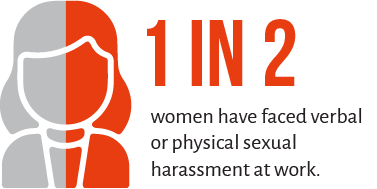
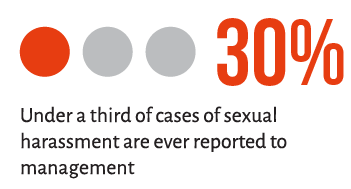
575 survey respondents, from eight countries, namely Kenya, Malawi, Zambia, Zimbabwe, Botswana, Tanzania, Uganda and Rwanda, responded to questions on sexual harassment at work - verbal and/or physical. It found:
Fear prevented many from filing formal complaints. These were the common concerns:
The absence of and lack of awareness of reporting mechanisms also explained inaction.
Almost half, 46.7%, of those surveyed said their organisation had no sexual harassment policy, 35.9% were unaware of what was in the policy and just 17.4% were aware of its contents.
Of the 32 managers interviewed 68.7% said their organisation had a sexual harassment policy - 46.7% had been trained on it.
Perhaps the biggest impedance in reporting is that the perpetrators are often managers or supervisors - people with responsibility and power. Survey respondents identified their harassers as fellow employees (in 38.8% of cases) but 22.1% of the time they were direct supervisors and in 19.4% of cases, members of higher management.
When action was taken in 57% of cases reported, the most common organisation response was to warn the perpetrator (46.2%). 14.5% of responses said training was offered and 9.7% had the case dismissed.
“The research highlights a lack of trust in the organisation, or sometimes complete failure of management and systems, to deal effectively with sexual harassment,” said Melanie Walker, WAN-IFRA’s Executive Director, Media Development and Women in News.
“This matters because the less confidence there is in an organisation’s ability to address the problem, fewer people will see value in calling it out, and so the cycle will perpetuate.” There are solutions, however, beginning with owners and managers acknowledging the problem exists and then committing to ensuring a safer working space, not just for women, but for all staff. It is vitally important to change the culture of silence around harassment. And this culture change can only come from the very top.”
In supplementary interviews with 32 media managers, we found
“There are divergent views on the scale of sexual harassment between the survey respondents and managers we interviewed. There is no simple explanation for this - but what is common is that both staff and managers have had first-hand experience of sexual harassment, and in most cases chose not to report it. This suggests fear of victimisation runs alongside a lack of confidence in management systems and any apparent remedies,” said Walker.
Women in News, which offers expert input on how to manage sexual harassment, is starting to see little victories among those media organisations that have begun to actively manage the problem - starting with adopting policies and procedures that the staff can support. “But the numbers are very small and we have a very long way to go before staff are convinced and comfortable that if there are incidents of harassment, they can report them, and action will be taken, without further victimisation,” said Jane Godia, Africa Director of WIN and an expert and trainer managing sexual harassment.
“We are still working on changing perceptions and debunking cultural beliefs that perpetuate sexual harassment,” said Godia.
يقدم هذا البحث دليلاً علمياً على أهمية حاجة المؤسسات الإعلامية إلى التعرف على مدى انتشار التحرش الجنسي وضرورة وضع خطط لخطوات تنفيذية نحو توفير بيئة عمل أكثر أماناً.
“It all starts with a conversation on what is and isn’t acceptable behaviour in your media organisation. - being explicit about sexual harassment - sharing definitions, what behaviours are unacceptable, and communicating the right for every employee to be treated equally. It is not enough to have a policy; staff and managers must be trained on what the procedures are for making and managing a complaint. Everyone should be clear about the consequences of sexual harassment. It is far better to be proactive and prepared than pushed into a crisis management position when a case emerges,” said Walker.
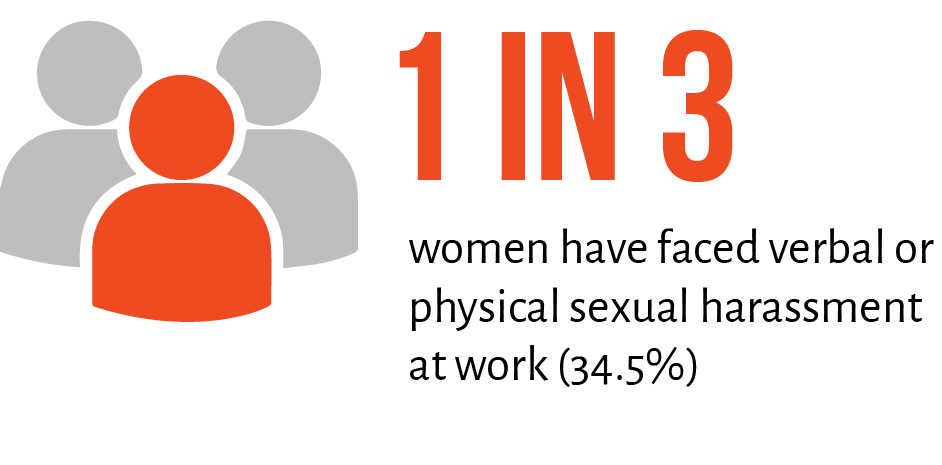
The way media organisations are managed is, generally, influenced by a belief that employees know how to behave. However, the reality is that sexual harassment remains quite prevalent - particularly for women - and often goes unreported. With less than one in six cases being reported to management, a culture of silence and fear persists.
This problem is compounded by a discrepancy between executives and employees on the scale of the problem. Despite one in three women having faced sexual harassment at work, 84.1% of executives interviewed believe sexual harassment isn’t a problem in the news industry. This is a significant perception gap.
These results form part of a multi region-study to provide the evidence of the extent of sexual harassment. The full research will help better understand the similarities and differences facing media in the Global South.

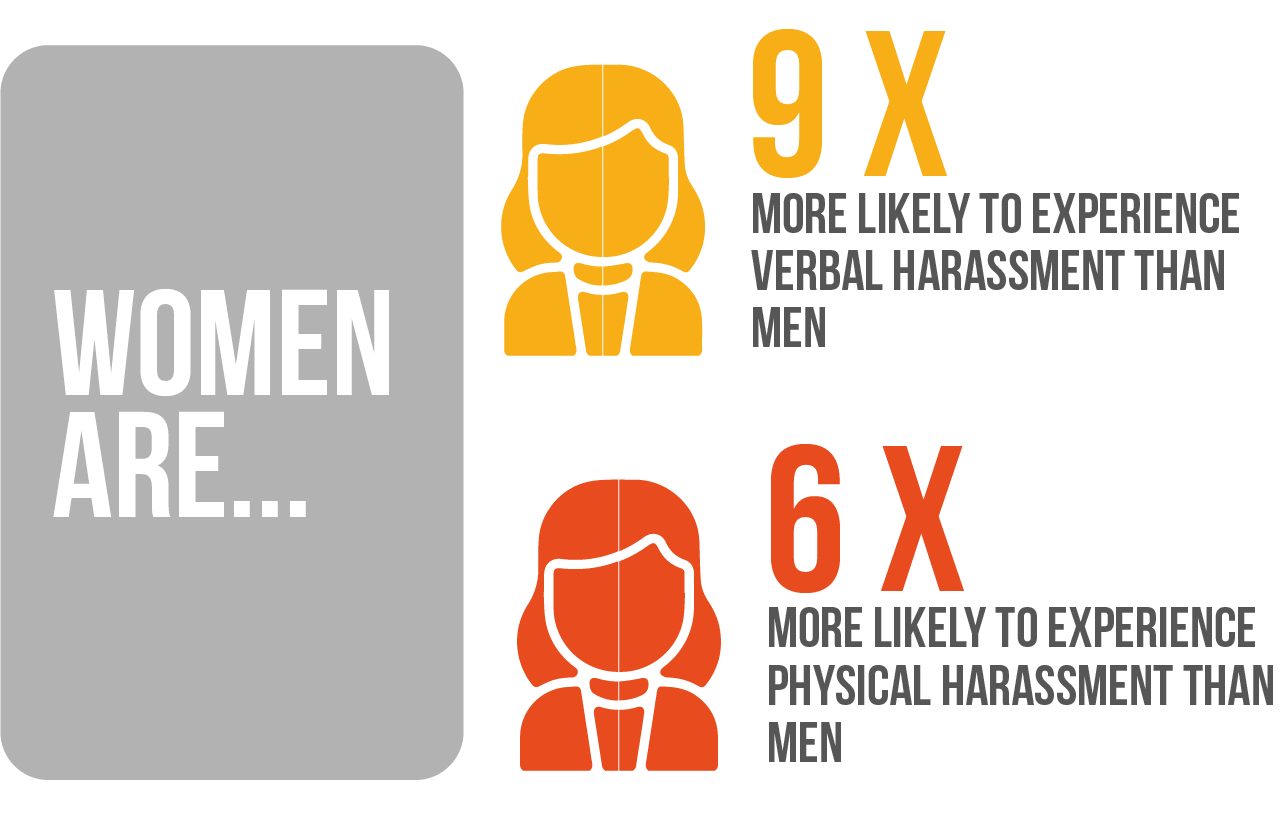
494 survey respondents, from five countries, namely Indonesia, Myanmar, Malaysia, Philippines, and Vietnam, responded to questions on sexual harassment at work - verbal and/or physical. It found:

Underreporting of sexual harassment is endemic at both the employee and executive level. Along with the 15% reporting rate of survey respondents, executives themselves only reported incidents that happened to them 33% of the time (six of the 19 executives who had experienced sexual harassment however only two had reported it).
Of course we would like to see action always be taken, but with only 42% of executives indicating they were aware of their company’s sexual harassment policy the results are unsurprising.
In supplementary interviews with 19 media executives, we found
Increasing education about sexual harassment policies and how to implement them are a first step to improving the instances of action being taken. With only three of the eight executives who knew about the policies having been personally trained, this could make a big impact. This is supported by the more than half of executives who called for more training on what constitutes sexual harassment and how to respond.
Perhaps the biggest impedance in reporting is that the perpetrators are often managers or supervisors - people with responsibility and power. Survey respondents identified their harassers as fellow employees (in 35.2 % of cases) but %, 18.6% of the time they were members of higher management and in 12.7% of cases, direct supervisors.
“The research highlights disagreement about the prevalence of sexual harassment in newsrooms. 73.6% of executives believe it isn’t a problem, with an additional 10.5% believing it is a thing of the past. This is in stark contrast to the just over one in three women who have experienced some form of harassment at work - as well as the 4% of men,” said Melanie Walker, WAN-IFRA’s Executive Director, Media Development and Women in News.
“This is problematic because the first step in addressing sexual harassment is understand what it is and agreeing that it exists. We are glad to see executives agreeing that more training is needed to better understand sexual harassment and how to manage it. We are optimistic that continuing to work with media organisations across the region will help redress disagreements or misunderstanding.”
Women in News, which has recently expanded into Southeast Asia, offers expert input on how to manage sexual harassment. Working directly with newsrooms as well as individuals through the Leadership Accelerator, managers and employees can be equipped with the policies and procedures to actively manage the problem. But perhaps even more importantly, individuals get help to understand their rights and media organisations understand their responsibilities. “It is a long road ahead, starting with building a common understanding of what sexual harassment is and why it persisits. Removing it from every newsroom will create safer working environments and ones in which women can more easily thrive,” said Khin Thandar Htay, Southeast Asia Director of WIN.
يقدم هذا البحث دليلاً علمياً على أهمية حاجة المؤسسات الإعلامية إلى التعرف على مدى انتشار التحرش الجنسي وضرورة وضع خطط لخطوات تنفيذية نحو توفير بيئة عمل أكثر أماناً.
“It all starts with a conversation on what is and isn’t acceptable behaviour in your media organisation. - being explicit about sexual harassment - sharing definitions, what behaviours are unacceptable, and communicating the right for every employee to be treated equally. It is not enough to have a policy; staff and managers must be trained on what the procedures are for making and managing a complaint. Everyone should be clear about the consequences of sexual harassment. It is far better to be proactive and prepared than pushed into a crisis management position when a case emerges,” said Walker.
Women in Russian media are four times more likely to experience sexual harassment than men. A report on the scale of sexual harassment in Russia has shown how pervasive it is, yet just one-quarter of cases are ever reported to the management.
The research, commissioned by the World Association of News Publishers’ (WAN-IFRA) Women in News programme found that of those women media professionals who experienced harassment, 31% experienced verbal harassment and 14% experienced physical attacks. 22% of media professionals (men, women and gender non conforming individuals) report to experiencing harassment or some kind.
The survey, which is part of a multi-region study undertaken in partnership with City, University of London, set out to collect data on the scale of sexual harassment in media organisations in Russia, and to establish what was being done to provide safer newsrooms. 176 media professionals were surveyed. Supplementary in-depth interviews were conducted with 16 media executives.
WIN has been engaging with journalists and media managers on sexual harassment for more than 10 years. In that time, we have collected plenty of anecdotal evidence of sexual harassment. But this is the first time we have been able to draw on large-scale data to support the belief that it is prevalent everywhere and is a significant impediment to a healthy media industry, regardless of country or cultural context.
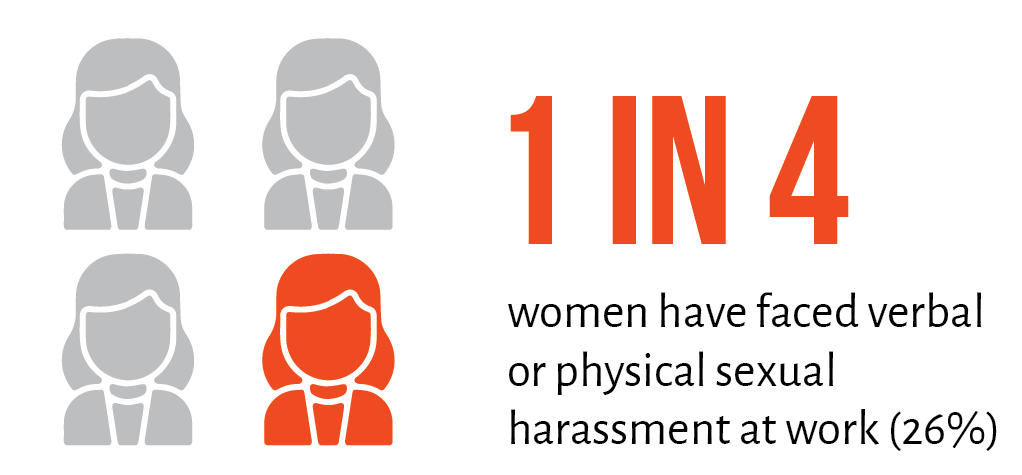
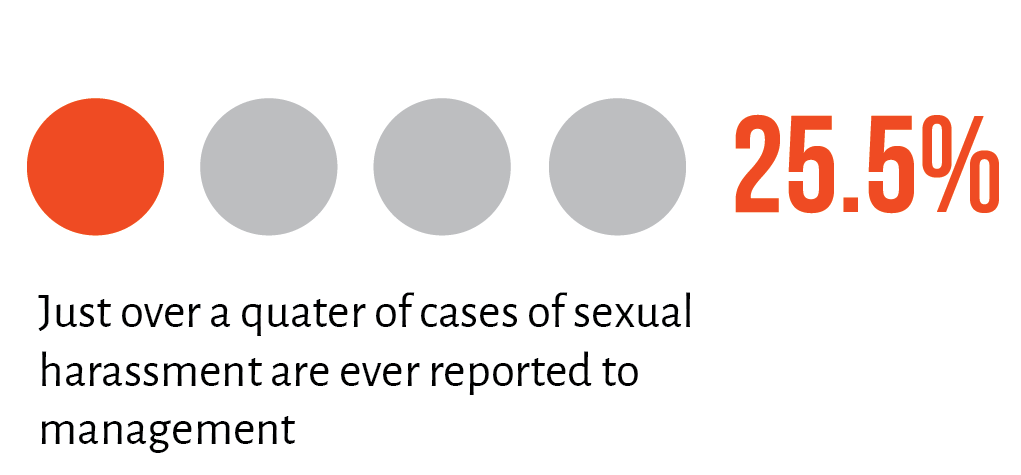
While sexual harassment in newsrooms for women is much more prevalent, men have not been spared.- though they are four times less likely to experience it than women, of those surveyed, 12 per cent had experienced verbal sexual harassment. None of them had been physically harassed.
Overall, just under one in four respondents (23.4%) had witnessed at least one incident of sexual harassment at work – but reporting of these cases remained low at 25.5 per cent.
The survey found:
In Russia, an average of 25.5% of cases of sexual harassment were reported to the management at media organisations. While 62% of these result in action by management, the low reporting rate means the majority of perpetrators are never disciplined and survivors never receive support.
Fear - fear of losing a job, negative repercussions, retaliation or being negatively labelled - was the prevailing reason for not reporting. Combined, it represents 39.7% of responses.
The top individual reasons \were no known reporting mechanisms (17.1%) and not thinking it was a big deal (15.3%).
Further, when respondents did report sexual harassment, news organisations took action less than two-thirds (62%) of the time. The most common responses from organisations when they took action were:
Direct action against the perpetrator almost never occurred. Firing, transfer, and suspension of the perpetrator were each only reported one time. The most common source of sexual harassment were fellow employees, followed by management (34.2%, combined total of direct supervisor and higher management).
“Understanding abuse of power is crucial to understanding who sexual harassment happens to and why. It tends to have nothing to do with sincere sexual or social interest. Instead, it happens where there are unequal relationships, for example between a superior and their subordinate, or between an older employee and a younger employee,” Melanie Walker, Executive Director, WAN-IFRA Women in News.
When asked if sexual harassment is an issue in the news industry, 15 news executives responded no, and one said maybe. This is in stark contrast to the 35% of women who reported experiencing verbal sexual harassment and 17% who reported experiencing physical harassment. This gap may also explain why 35% of responses said that organisational barriers, such as no reporting mechanism, not knowing how to report or thinking they wouldn’t be believed, were why they didn’t report the harassment they experienced.
To understand management perspectives on the prevalence of sexual harassment, WIN interviewed 16 managers and executives: 11 were women and five were men.
Three women stated they had experienced sexual harassment, but none had reported this.
The consensus between the news executives was that sexual harassment may occur in Russia in general, but it was an issue to be reported on, not one that was experienced by news personnel.
“I don’t think sexual harassment is a problem. If an issue arises, staff know how to defend themselves. Moreover, I have women who will fight back against anyone if this happens. We are all in a transparent environment; we see each other,” said one editor-in-chief.
“It is difficult for me to answer this question unequivocally. The honest answer: more likely yes than no,” said a deputy editor-in-chief.
When asked if any of their employees had reported cases of sexual harassment to them, three of the 16 executives answered yes, and their response was to discuss the incident with those concerned.
On reduced complaints, one CEO said: “Since the beginning of the #MeToo movement, many men have been rethinking their actions. Nonetheless, I remain concerned about sexual harassment and realise we can do better.”
Interestingly, when we asked respondents if their work environment was supportive, for women, 76.2% somewhat to strongly agreed they could openly talk to their supervisor, 88.1% somewhat to strongly agreed they felt listened to at work, and 88.8% somewhat to strongly agreed they felt safe in their newsroom. This seems to be in contrast to their experiences.
In response to a question on whether or not the executives believed their employees felt comfortable reporting sexual harassment incidences to their news organisations, 12 said yes.
“I’m sure about the women. They certainly would tell. They always talk about their problems: from health problems to personal dramas and breakups. With men, I’m not so sure. A man should deal with his problems on his own - this is the Russian mentality. You’re not a man if you show your weakness or ask for help,” said one general director.
Executives’ beliefs that sexual harassment is a non-issue in their workplace contrast with the respondents’ views, where one in four women have experienced either unwanted verbal or physical harassment at work.
Respondents said the perpetrator was most likely a fellow employee but that they do receive significant unwanted attention from people in power in the organisation - namely supervisors and executives.
The overarching stand from managers that there was no need for explicit sexual harassment policies and procedures may explain why reporting is low. A common reason for not reporting was dismissing the event as no big deal. However, one respondent pointed to a feeling of shame around verbal harassment, in line with cultural norms that silence victims.
Additionally, when asked if they knew if their organisations had an anti-sexual harassment policy, of the 16 news executives, only two were aware of such a document. And when asked to provide suggestions for eliminating sexual harassment in the news industry, they focused on the importance of communication in creating a comfortable atmosphere. Most executives believe this exists in their workplace, therefore, sexual harassment is not a significant issue.
The research findings go beyond anecdotes and demonstrate that sexual harassment does exist in Russian media organisations. The managers’ confidence that their workplaces, with their open communication policies, are not hotbeds for harassment, feeds into the notion that sexual harassment is a problem of the past and continues to create unsafe work environments for all of their staff.
The first step is making sure executives really understand what constitutes sexual harassment and just how pervasive it is. Only from there can policies be enacted and working cultures change to stamp out this scourge from all media organisations and, ultimately, all workplaces in general.
“The study showed that many publishers try to create an open, friendly atmosphere in their newsrooms and sincerely believe that this protects against harassment. But incidents can happen in any team and in any organization. It is important to know what to do and how to proceed in this case in order to protect people. You should have the reporting mechanisms, the investigative procedures and rules, the understanding of actions in response. The study revealed they do not exist, or employees do not know about them. Together with WIN WAN-IFRA, ANRI-MEDIA is taking very first steps in this direction to help media outlets create a safe business environment. For example, we adopted a WIN Guide on countering harassment in the media with practical templates and recommendations." Anna Koshman, ANRI-Media
على الرغم من أن 85٪ من حوادث التحرش الجنسي لا يتم الإبلاغ عنها داخل مجال صناعة الإعلام العربي، إلا أن الإدارات المؤسسية بدأت في اتخاذ بعض الإجراءات الملموسة لكسر دائرة الصمت.
شارك نحو 526 إعلامياً وإعلامية في استطلاع الرأي الذي أجراه برنامج "النساء في الأخبار" بالتعاون من جامعة سيتي بلندن في الفترة من شباط/فبراير وحتى نيسان/أبريل 2021 من خلال استبيانات على الإنترنت في مصر والأردن ولبنان وفلسطين كجزء من دراسة بحثية شاملة متعددة المناطق، لتقديم أدلة علمية حول قضية التحرش الجنسي في الإعلام. وجاءت المشاركة الأكبر لصالح النساء (أكبرمن نصف المشاركين بقليل - 54٪).
أوضح تحليل النتائج أن واحدة من كل ثلاث نساء في المتوسط واجهت شكلاً من أشكال التحرش الجنسي في العمل (35٪) ، أكثر من 50٪ تعرضن للتحرش اللفظي – إلا أن الحالات التي تم الإبلاغ عنها لم تتجازو 12٪ فقط من الحوادث. وفي إطار الحالات التى تم إبلاغ الإدارة بها فإن 50٪ من هذه الحالات نتج عنها إجراءات رسمية من جانب المؤسسة عندما كان القائم بالبلاغ رجلاً ، مقابل 41٪ لحالات النساء.
بالإضافة إلى ذلك، عندما تم سؤال المجيبين/ات عمّا إذا كانت مؤسستهم لديها سياسة مناهضة للتحرش الجنسي، أوضح 7٪ فقط من إجمالي المجيبين/ات أن هناك سياسة مطبقة وهم/نّ على علم بها، ممّا يوضح ضرورة توافر المزيد من الجهود لإقرار سياسات مناهضة التحرش الجنسي فى المؤسسات الإعلامية وإعلام كافة العاملين/ات بوجودها وإجراءاتها، ضماناً لتحقيق الشفافية، وتأكيداً على حرص المؤسسة على سلامة وأمن العاملين/ات بها والذين يمثلون القوة الحقيقية وراء أي نجاح.
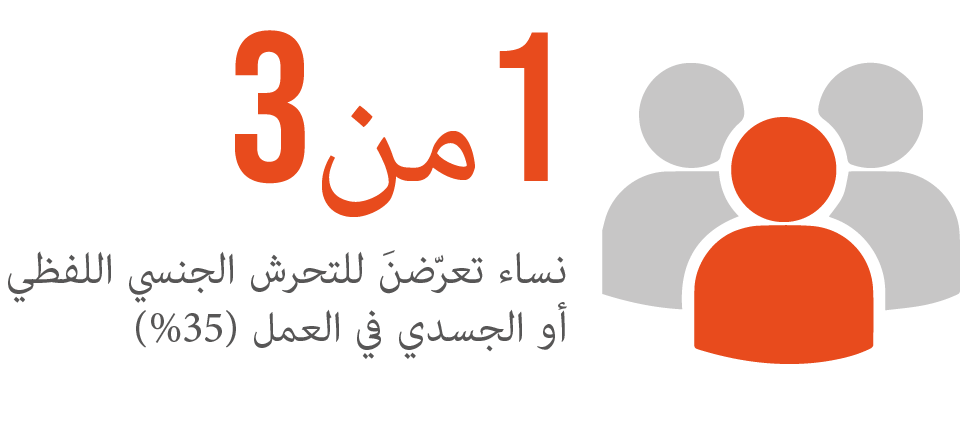


تم طرح أسئلة على المشاركين/ات خلال الدراسة حول أنواع التحرش الجنسي الذي واجهوه في العمل، وظهر أن النساء كنّ أكثر عرضة بمرتين للتحرش اللفظي مقارنة بالرجال (52٪ فى مقابل 24٪ على التوالي)، كذلك تسع الفجوة بين الجنسين بشكل أكبر عند مقارنة البيانات المتعلقة بالتحرش الجسدي (19٪ للنساء و7٪ للرجال).
وإضافة لما سبق، فإن عدداً صغيراً من المشاركين/ات فضّلوا عدم تحديد جنسهم/نّ في الدراسة (حوالي 15٪ من الإجمالي العام)، وفي هذا الإطار عبّرت تلك النسبة عن تعرض 29٪ منهم/نّ للتحرش اللفظي، وكذلك 14٪ للتحرش الجسدي.
كذلك، ذكر واحد من كل اثنين من المشاركين/ات في البحث أنهم/نّ شهدوا/ن تحرشاً جنسياً - 13.5٪ من الإجمالي العام بواقع خمس مرات أو أكثر، ممّا يشير إلى حجم ومدى انتشار القضية في مجال العمل الإعلامي.
وبالنظر للنتائج التفصيلية للدراسة، يمكننا القول بأن التحرش الجنسي لا يزال موجوداً بشكل عميق في قطاع الإعلام، ممّا يؤكد ضرورة وأهمية اتخاذ إجراءات صارمة للتعامل معه بشكل رسمي وفعّال، وذلك على النحو التالي :

يعد عدم الإبلاغ عن التحرش الجنسي أمراً مستوطناً، ومن ثم فإن توفير مساحة آمنة للتحدث بحرية عن تلك الحالات وضمان توافر السرية والحماية، بالإضافة إلى زيادة الوعي بأهمية الإبلاغ، وإظهار القيمة المضافة لحماية الآخرين من تكرار التعرض أو مشاهدة مثل هذه المواقف أمراً لا يقبل المساومة أو التسويف.
لذا تطرح نتائج هذه الدراسة كذلك بصيصاً من الأمل عند النظر في التعامل مع الحالات المبلغ عنها، إذ أوضح التحليل أن المؤسسات الإعلامية قامت فعلياً باتخاذ إجراءات رسمية عند الإبلاغ بنسبة 46٪ من إجمالي الحالات التى تم الإبلاغ عنها، الأمر الذي يمثل خطوة إلى الأمام لتفعيل الدور التنظيمي للمؤسسات والتأكيد على أهميته في ضمان سلامة وأمن كافة الموظفين/ت في بيئة العمل.
وعند السؤال عن أهم الأسباب المدرجة لعدم الإبلاغ يأتى فى المقدمة عدم وجود آلية إبلاغ معروفة أو محددة (17.3٪) ، يليها عدم وجود أدلة لإثبات واقعة التحرش (13.8٪) ، وفي المرتبة الثالثة يأتي عدم الرغبة في أن يتم وصم المبلغ/ة بشكل سلبي (12.8٪) . وعن أكثر ردود المؤسسات شيوعًا بعد الإبلاغ يأتي هي فصل المتهمين/ات (24.5٪) ، أو إغلاق التحقيق دون أن يسفر ذلك عن أي إجراء آخر (20.5٪).
تكشف أسباب عدم الإبلاغ بصورة واضحة عن طرق معالجة القضية وأهم السبل التي يمكنها تشجيع الأشخاص على الإبلاغ عن هذه الوقائع ومن ثم إمكانية التعامل معها بشكل أكثر فعالية، سواء من خلال تبني آلية واضحة وشاملة للتطبيق تضمن تحقيق العدالة، وتساعد في تغيير الثقافة المؤسسية نحو سياسات أكثر انفتاحاً وشفافية بدلاً من الوصم والخذلان وإلقاء اللوم.
أوضح المشاركون/ات في الدراسة أن المصدر الأكثر شيوعًا للتحرش الجنسي في بئة العمل الموظف/ة الزميل/ة بواقع (42.9٪) ، يليه المشرف/ة المباشر/ة بنسبة (22.2٪) ، ثم الإدارة العليا (14.6٪) ، ومصادر أخرى (10.7٪) ، وفي المرتبة الخامسة يأتى مصدر الأخبار (9.5٪).
تشير الأرقام السابقة إلى أن معظم حوادث التحرش الجنسي تحدث داخل بيئة المؤسسات الإعلامية في العمل، سواء يأتي ذلك من نفس المستوى الإداري أو أعلى، وعليه ينبغي اتخاذ إجراءات صارمة لمساعدة كافة الموظفين/ت لضمان الشعور بالأمان داخل البيئة الفيزيائية للعمل.
يقدم هذا البحث دليلاً علمياً على أهمية حاجة المؤسسات الإعلامية إلى التعرف على مدى انتشار التحرش الجنسي وضرورة وضع خطط لخطوات تنفيذية نحو توفير بيئة عمل أكثر أماناً.
تقول ميلاني والكر – الرئيسة التنفيذية لبرنامج "النساء فى الأخبار" ومديرة برامج التنمية الإعلامية في المنظمة العالمية للصحف (وان-ايفرا): "كل شيء يبدأ بإجراء الحوار حول السلوك المقبول وغير المقبول داخل مؤسستك الإعلامية. الصراحة بشأن التحرش الجنسي، والتشارك فى التعريفات والمفاهيم، وتحديد السلوكيات غير المقبولة، وإيصال حق كل موظف/ة في أن يعامل على قدم المساواة مع الآخرين أمور أساسية. لا يكفي أن يكون لديك سياسة مكتوبة ومحفوظة في الأدراج، وإنما يجب تدريب الموظفين/ات والمديرين/ات على إجراءات تقديم الشكوى وإدارتها. يجب أن يكون الجميع واضحاً بشأن عواقب التحرش الجنسي سواء على مستوى الفرد أو المؤسسة أو المجتمع ككل."
The media industry in Nicaragua and El Salvador has a sexual harassment problem. On average, 74% of women in media have experienced verbal sexual harassment. More than 40% have experienced physical harassment. These are amongst the highest rates of sexual harassment of all countries surveyed in the 20-country study, completed in November 2021.
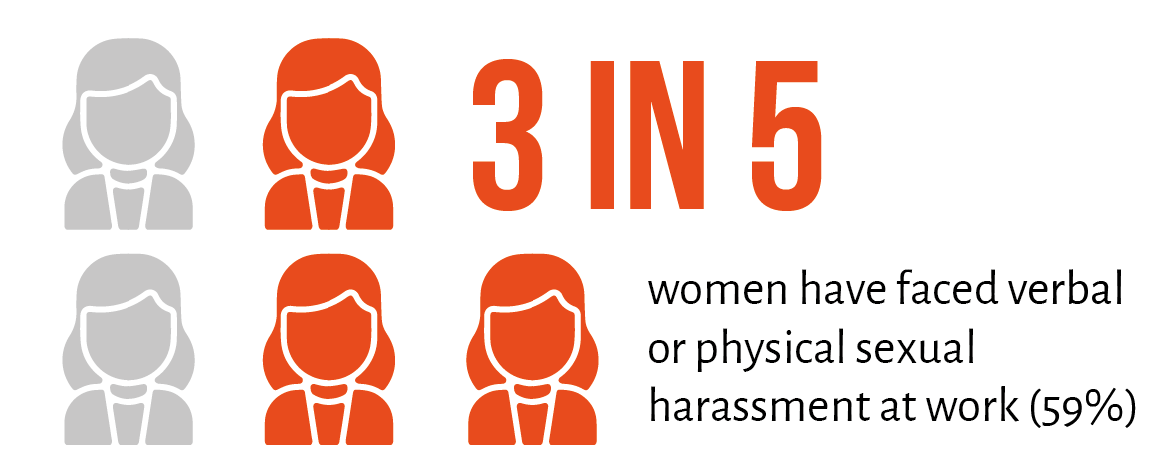
234 media professionals in Nicaragua and El Salvador participated in a survey, in addition to 18 media executives who provided supplementary in-depth interviews to understand the extent of sexual harassment in the industry.
The data shows that women are disproportionately affected, experiencing verbal and physical sexual harassment at least four times more than men. Moreover, women experience sexual harassment far more often than men, with almost half of the women surveyed indicating they have experienced verbal sexual harassment five times or more, compared to 5.8% of men.

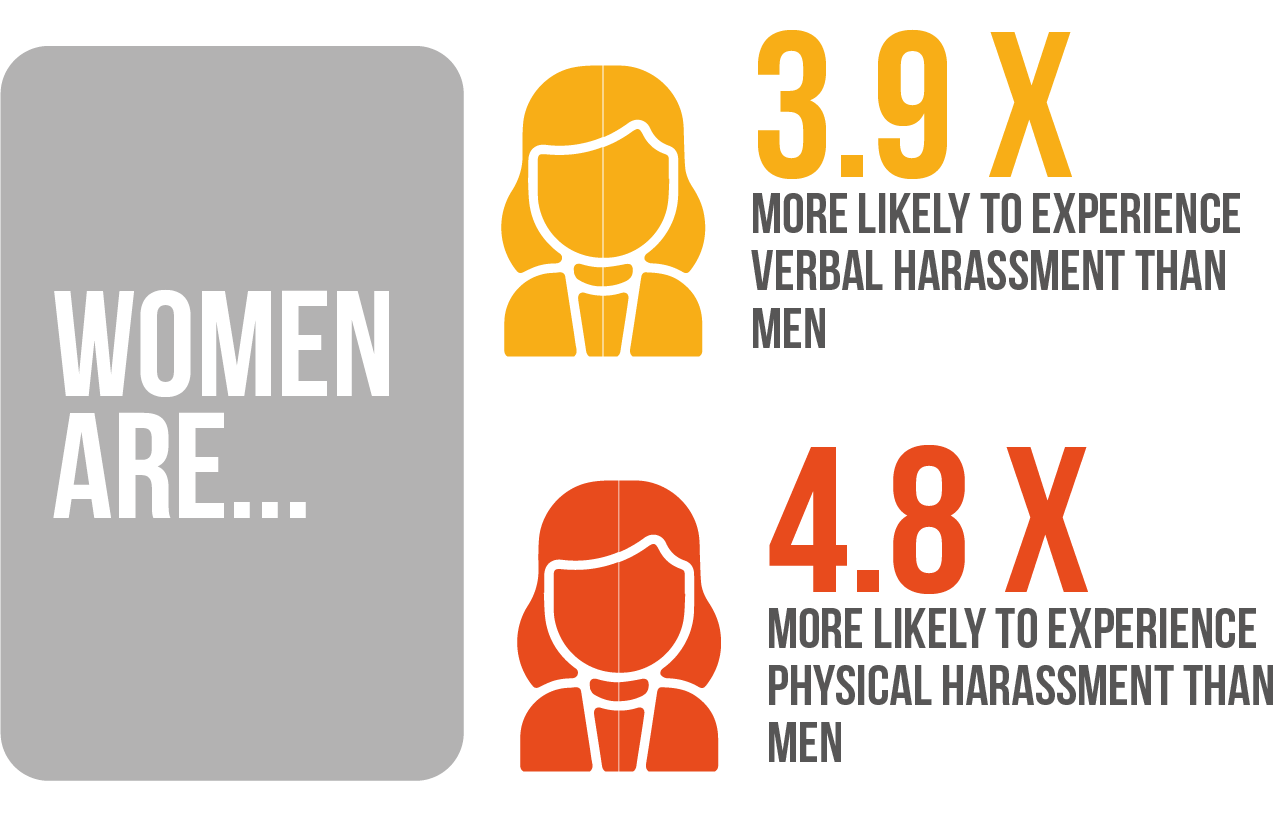
Given these high figures, it is not surprising that almost 60% of the participants had witnessed at least one incident of sexual harassment with 21% stating they had seen five or more. The most common source of sexual harassment was a fellow employee (42%), followed by higher management (25%).
Despite the high prevalence of sexual harassment, on average only one in every four cases was reported. Action was taken in just under half (46%) of incidents that were reported. Responses from both survey participants and news executives indicated the lack of a known sexual harassment policy. This is reflected by the survey respondents, where the top reasons for not reporting cited were ‘no known reporting mechanism available’ and ‘not knowing how to report’. The other reasons for not reporting were ‘fear of perpetrator retaliation’ or ‘fear of a negative impact in their professional career’.

Interestingly, when the interviewed news executives were asked if sexual harassment was a problem, the majority said yes, but not in their newsroom. More than half of the news executives interviewed stated that their newsrooms were exceptions to the overall atmosphere in the news industry, were sexual harassment was common.
The most common responses of organisations when they took action was warning the perpetrator (56.4%), offering emotional support for the victim (16%), and the victim being transferred to another department (10.3%).
Media organisations in Central America need to recognise the extent of sexual harassment and put in mechanisms to provide a safer working environment. The research shows that sexual harassment is a significant problem. The lack of policies aimed at preventing sexual harassment and at addressing it properly when it occurs, along with the common fear to report results in high levels of sexual harassment in the Central American media industry that go largely unchecked.